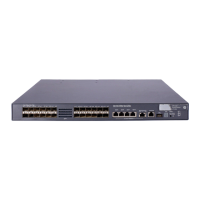15
To do… Use the command… Remarks
5. Configure the size of the data
field in each ICMP echo
request.
data-size size
Optional.
100 bytes by default.
6. Configure the string to be
filled in the data field of each
ICMP echo request.
data-fill string
Optional.
By default, the string is the
hexadecimal number
00010203040506070809.
7. Apply ICMP echo tests to the
specified VPN.
vpn-instance vpn-instance-name
Optional.
By default, ICMP echo tests apply
to the public network.
8. Configure the source interface
for ICMP echo requests. The
requests take the IP address of
the source interface as their
source IP address when no
source IP address is specified.
source interface interface-type
interface-number
Optional.
By default, no source interface is
configured for probe packets.
The specified source interface
must be up; otherwise, no ICMP
echo requests can be sent out.
9. Configure the source IP
address of ICMP echo
requests.
source ip ip-address
Optional
By default, no source IP address is
configured.
If you configure both the source ip
command and the source
interface command, the source ip
command takes effect.
The source IP address must be the
IP address of a local interface.
The local interface must be up;
otherwise, no ICMP echo requests
can be sent out.
10. Configure the next hop IP
address of ICMP echo
requests.
next-hop ip-address
Optional.
By default, no next hop IP address
is configured.
11. Configure optional
parameters.
See “Configuring optional
parameters for an NQA test
group”
Optional.
NOTE:
NQA ICMP echo tests are not supported in IPv6 networks. To test the reachability of an IPv6 address,
use the ping ipv6 command. For more information about the command, see “System maintenance and
debugging
.
”
Configuring DHCP tests
DHCP tests of an NQA test group are used to test if a DHCP server is on the network, and how long it
takes for the DHCP server to respond to a client request and assign an IP address to the client.

